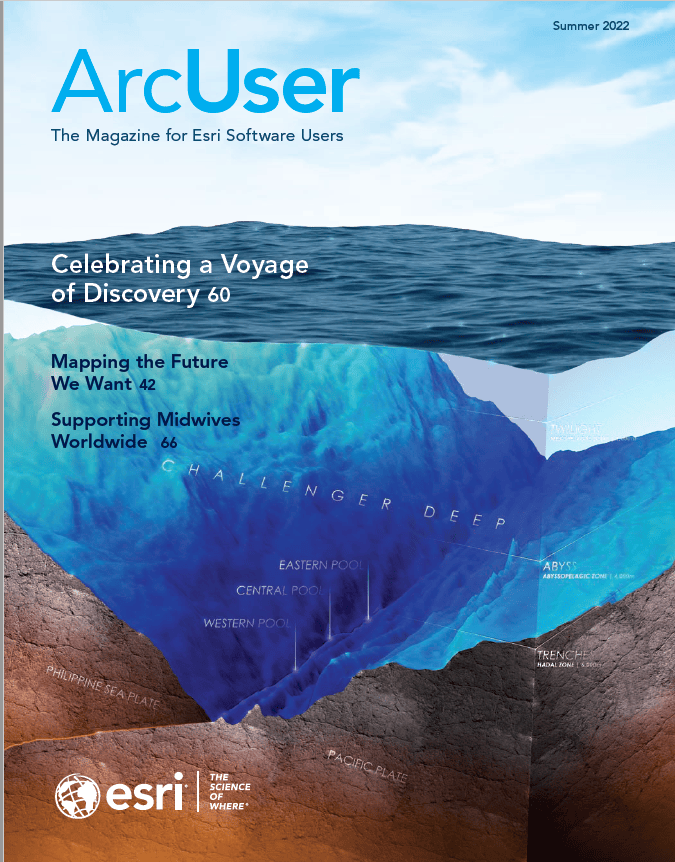One of the most effective ways to develop geospatial skills across your organization is to establish a geospatial community of practice (CoP). GIS professionals need to use the power of community to share knowledge and develop thought leadership, and a CoP is one way to do just that. Learn how you can build a CoP that will unlock new possibilities for GIS within your organization.
As we’ve worked with customers over the last few years to help them design geospatial strategies and governance programs, we’ve learned that businesses are changing dramatically in terms of what they expect of geospatial technology professionals. The knowledge, skills, and responsibilities of GIS teams are evolving in response to the growing demand for location intelligence.
Today, more than ever, organizations realize the power of real-time monitoring, spatial analysis, and location-based analytics. Organizations that leverage geospatial technology and analysis across many business functions can extract much greater value from their GIS-related investments, and a big part of that value equation is people—namely, GIS professionals.
GIS professionals work with many different areas of an organization. They’re increasingly forced to understand various business lines to apply their geospatial knowledge and implement spatial solutions to address unique business problems.
Location is at the center of all community and urban planning practices. Planning professionals determine how, where, and when their designs can have the greatest impact on smart communities and improve the quality of life for residents. GIS professionals help to analyze, visualize, and evaluate the demographic needs of the community, and planners can design and measure the impact of different design scenarios. For GIS professionals to be effective in this example scenario, they must have a working knowledge of urban planning practices and analyze community patterns and trends to offer valuable insight to urban planners.
This is only one example, but in many situations, a well-rounded GIS professional needs geospatial competencies as well as business acumen, management expertise, good communication abilities, and analytical skills. Nurturing the combination of geospatial competencies and business skills is critical for a spatially intelligent organization.
One of the most effective ways to develop these skills across your organization is to establish a CoP—a forum where geospatial technology practitioners (including GIS professionals, information technology staff, and business experts) share knowledge, collaborate on issues, and develop resources for all members to use. The hope is that by engaging and connecting practitioners throughout your organization, you’ll have more dialogue on how to effectively use GIS to solve important business problems in ways that nonspatial technology simply can’t. Ultimately, the goal of a geospatial CoP is to develop a high level of spatial thought leadership in the organization, which raises the level of geoliteracy and unlocks innovative ways in which GIS can strategically contribute to the organization’s success.
Establishing a geospatial CoP takes time, but it can lead to tremendous benefits for your organization. To all members who participate, the community offers the opportunity to collaborate, share ideas and identify challenges. As geospatial adoption increases across the organization, dedicating time to connect with other GIS stakeholders creates an internal network of experts who can share information on how GIS is being used today.
One of the customers we work closely with uses the term GeoExcitement. We love this term and having a CoP can help generate this excitement about geospatial throughout the organization. Sharing successes, celebrating, and innovating together can reinforce positivity within the group and drive your geospatial program forward.
Here are a few of the most common benefits of establishing a CoP:
- It empowers the organization’s top GIS talent to act as an authority on geospatial business issues.
- It provides a level of shared accountability and oversight to govern the delivery of a GIS strategy.
- It reduces the risk of losing valuable geospatial-related business knowledge and processes.
- It establishes a focus on improving spatial data integrity and data management practices.
- It promotes innovation and spatial thought leadership throughout the organization.
- It connects the organization’s GIS users and leadership groups.
To develop a geospatial CoP, you’ll need buy-in from leadership. Identify leaders whose business lines are active in using spatial data, solutions, and services. They have a vested interest in developing the geospatial skills of their people to improve their own operations. With an active and engaged leadership group providing strong support, the CoP is much better positioned as an authority that will define how your organization will maximize the value of geospatial technology, your geospatial processes, and your workforce.
Next, you’ll need the proper arrangement of founding members from across the organization. Staff who use geospatial data and solutions in their jobs, ranging from technicians to leadership, should participate. Understand that a CoP shouldn’t be confused with the operational GIS team that supports and delivers geospatial services day to day. The power of a CoP is that members can come from a broad cross section of business lines and different levels of the organization. This not only supports collaboration across many department functions but helps tremendously with the outward communication of geospatial practices developed by members.
At first, you may start with a small group of users across various departments and gradually increase participation from others as interest grows. Inviting guests to participate from outside the organization is encouraged, as it would allow your CoP’s participants to gain perspectives from others.
Take the time up front to socialize the idea of a geospatial CoP. Gather input on the topics and issues your GIS team and business users find valuable and exciting. To consolidate and organize the information you have collected, we recommend creating a community charter. A charter is a document that outlines important information on the community’s purpose, objectives, and scope. It can also describe roles and responsibilities for the community chair, members, and potential working groups; decision-making processes; voting rights; and specific issues for the community to address.
The purpose of the charter is to formalize the levels of authority, the expected outcomes, and how the community will operate. Communities that have established clear, well-designed charters that have been accepted and approved by their organizations’ leadership tend to be more successful than those that are informal, which often flame out quickly because of a lack of focus and support.
Once you’ve established your charter, we recommend reviewing and updating your charter annually as your practice grows and matures. This way, you’ll ensure that the community is focused on the most pressing geospatial issues and business problems.
In the first year of your newly formed CoP, start with a narrow mandate and gradually expand the scope of responsibilities as the practice grows and matures. In the beginning, focus on the value and adoption of traditional geospatial patterns of use such as mapping, visualization, and data stewardship. Over time, expand the scope to include more advanced use cases involving asset management, real-time monitoring, and spatial analysis.
Below are a few areas that your CoP can focus on initially. Which one you choose will depend on your organization.
- Focus on the development or execution of the organization’s GIS strategy.
- Define a geospatial skills matrix to better understand competency strengths and weaknesses.
- Establish guidelines, procedures, and processes for spatial data management and maintenance.
- Define a list of policies and guidelines that need to be developed by the community.
- Consolidate a list of business needs so the community can plan for new technical capabilities.
- Coordinate cross-community working teams to investigate new industry practices and solutions.
- Monitor and report on the effectiveness of engagement practices, processes, and initiatives.
- Track and promote the long-term benefits realized from geospatial investments.
- Organize a lessons learned repository to harvest insight from past GIS projects.
Over time, your CoP will develop its own culture. As new individuals become introduced to and participate in the community, the dynamics of the group may adjust. That’s when your charter will come into play, as it will help you enforce the rules of engagement for the community. Different personalities, backgrounds, and communication styles will be present. However, rooting the community in core values of inclusion, diversity, a sense of belonging, trust, openness, and a shared purpose can help it succeed in the future.
Lastly, one of the most critical success factors is to keep people engaged over the long run. The secret is that you need to keep your CoP’s activities fun and relevant. We’ve all been in those recurring meetings that start strong and become dull when the same agenda is used consistently. Get input on future topics for discussion and collect feedback on sessions to get a sense of what went well and what needs improvement.
Remember that building a flourishing geospatial CoP is a long-term journey. Develop a charter and then use that document as a guide to set agendas, record decisions, and publish outcomes like CoP-endorsed standards that all GIS users across the organization can use and find valuable. Report to leadership on issues, make recommendations, and lead the organization to evaluate new geospatial solutions and services.
Over the long term, a thriving CoP will become the hub of geospatial thought leadership in your organization. Its members will become trusted advisers that collaborate with all areas of the organization to address unique business problems with practical geospatial solutions. The power of our community is what makes GIS such an exciting field to be part of. It’s an important job to harness that community and put it to work to make a real difference for your organization.




